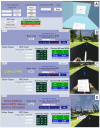The Effects of Competition on Exercise Intensity and the User Experience of Exercise during Virtual Reality Bicycling for Young Adults
- PMID: 39517772
- PMCID: PMC11548122
- DOI: 10.3390/s24216873
The Effects of Competition on Exercise Intensity and the User Experience of Exercise during Virtual Reality Bicycling for Young Adults
Abstract
Background: Regular moderate-vigorous intensity exercise is recommended for adults as it can improve longevity and reduce health risks associated with a sedentary lifestyle. However, there are barriers to achieving intense exercise that may be addressed using virtual reality (VR) as a tool to promote exercise intensity and adherence, particularly through visual feedback and competition. The purpose of this work is to compare visual feedback and competition within fully immersive VR to enhance exercise intensity and user experience of exercise for young adults; and to describe and compare visual attention during each of the conditions.
Methods: Young adults (21-34 years old) bicycled in three 5 min VR conditions (visual feedback, self-competition, and competition against others). Exercise intensity (cycling cadence and % of maximum heart rate) and visual attention (derived from a wearable eye tracking sensor) were measured continuously. User experience was measured by an intrinsic motivation questionnaire, perceived effort, and participant preference. A repeated-measures ANOVA with paired t-test post hoc tests was conducted to detect differences between conditions.
Results: Participants exercised at a higher intensity and had higher intrinsic motivation in the two competitive conditions compared to visual feedback. Further, participants preferred the competitive conditions and only reached a vigorous exercise intensity during self-competition. Visual exploration was higher in visual feedback compared to self-competition.
Conclusions: For young adults bicycling in VR, competition promoted higher exercise intensity and motivation compared to visual feedback.
Keywords: aerobic exercise; bicycling; competition; enjoyment; eye-tracking; motivation; virtual reality; visual attention; visual feedback; wearable sensors.
Conflict of interest statement
The authors declare no conflicts of interest.
Figures






References
-
- American College of Sports Medicine . ACSM’s Guidelines for Exercise Testing and Prescription. American College of Sports Medicine; Indianapolis, IN, USA: 2018. - PubMed
-
- Du Y., Liu B., Sun Y., Snetselaar L.G., Wallace R.B., Bao W. Trends in Adherence to the Physical Activity Guidelines for Americans for Aerobic Activity and Time Spent on Sedentary Behavior Among US Adults, 2007 to 2016. JAMA Netw. Open. 2019;2:e197597. doi: 10.1001/jamanetworkopen.2019.7597. - DOI - PMC - PubMed
MeSH terms
Grants and funding
LinkOut - more resources
Full Text Sources
Medical

